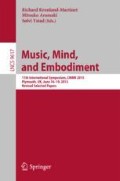Abstract
An automatic analyzer based on the generative theory of tonal music (GTTM) for acquiring a time-span tree is described. Although an analyzer based on GTTM was previously reported, it requires manually manipulating 46 adjustable parameters on a computer screen in order to analyze a time-span tree properly. We reformalized the time-span reduction in GTTM on the basis of a probabilistic model called probabilistic context-free grammar, which enables acquiring the most likely time-span tree. Applying leave-one-out cross validation over 300 datasets revealed that the new analyzer outperformed our previously developed GTTM analyzer.
Notes
- 1.
Although the theory accepts homophonic music, we first restricted our target music to monophonic music. Recently, we attempted to develop a time-span tree analyzer for polyphonic music [7].
- 2.
Although we can use the Viterbi algorithm, in the experiment we did a full search. In future we plan to implement the Viterbi algorithm to reduce the computing time.
- 3.
When the user stops moving the iPhone/iPod Touch, the unit plays the backing melody of “The Other Day, I Met a Bear (The Bear Song)”. When the user shakes it vigorously, it plays heavy soloing. When the user shakes it slowly, it plays a morphed melody between the backing and heavy soloing. The ShakeGuitar can be downloaded at http://gttm.jp/hamanaka/en/shakeguitar/.
References
Charniak, E.: Tree-bank grammars. In: Proceedings of the Thirteenth National Conference on Artificial Intelligence, AAAI 1996, pp. 1031–1036 (1996)
Granroth-Wilding, M., Steedman, M.: Statistical parsing for harmonic analysis of jazz chord sequences. In: Proceedings of the International Computer Music Conference, pp. 478–485. International Computer Music Association (2012)
Hamanaka, M., Hirata, K., Tojo, S.: Implementing ‘a generative theory of tonal music’. J. New Music Res. 35(4), 249–277 (2006)
Hamanaka, M., Hirata, K., Tojo, S.: FATTA: full automatic time-span tree analyzer. In: Proceedings of the 2007 International Computer Music Conference (ICMC 2007), pp. 153–156 (2007)
Hamanaka, M., Hirata, K., Tojo, S.: Melody expectation method based on GTTM and TPS. In: Proceedings of the 2008 International Society for Music Information Retrieval Conference (ISMIR 2008), pp. 107–112 (2008)
Hamanaka, M., Hirata, K., Tojo, S.: Melody morphing method based on GTTM. In: Proceedings of the 2008 International Computer Music Conference (ICMC 2008), pp. 155–158 (2008)
Hamanaka, M., Hirata, K., Tojo, S.: Time-span tree analyzer for polyphonic music. In: 10th International Symposium on Computer Music Multidisciplinary Research (CMMR 2013), pp. 886–893 (2013)
Hamanaka, M., Hirata, K., Tojo, S.: Music structural analysis database based on GTTM. In: Proceedings of the 2014 International Society for Music Information Retrieval Conference (ISMIR 2014), pp. 325–330 (2014)
Hamanaka, M., Yoshiya, M., Yoshida, S.: Constructing music applications for smartphones. In: Proceedings of the 2011 International Computer Music Conference (ICMC 2011), pp. 308–311 (2011)
Hirata, K., Hiraga, R.: Ha-hi-hun plays Chopin’s etude. In: Working Notes of IJCAI 2003 Workshop on Methods for Automatic Music Performance and their Applications in a Public Rendering Contest, pp. 72–73 (2003)
Hirata, K., Matsuda, S.: Interactive music summarization based on generative theory of tonal music. J. New Music Res. 5(2), 165–177 (2003)
Hirata, K., Matsuda, S.: Annotated music for retrieval, reproduction. In: Proceedings of the 2004 International Computer Music Conference (ICMC 2004), pp. 584–587 (2004)
Kameoka, H., Ochiai, K., Nakano, M., Tsuchiya, M., Sagayama, S.: Context-free 2d structure model of musical notes for Bayesian modeling of polyphonic spectrograms. In: Proceedings of the 2012 International Society for Music Information Retrieval Conference (ISMIR 2012), pp. 307–312 (2012)
Kanamori, K., Hamanaka, M.: Method to detect GTTM local grouping boundarys based on clustering and statistical learning. In: Proceedings of the 2014 International Computer Music Conference (ICMC 2014), pp. 1193–1197 (2014)
Lerdahl, F.: Tonal Pitch Space. Oxford University Press, Oxford (2001)
Lerdahl, F., Jackendoff, R.: A Generative Theory of Tonal Music. Cognitive Theory and Mental Representation. MIT Press, Cambridge (1985)
MakeMusic: Finale (2015). http://www.finalemusic.com/
Marsden, A.: Software for Schenkerian analysis. In: Proceedings of the 2004 International Computer Music Conference (ICMC 2011), pp. 673–676 (2011)
Miura, Y., Hamanaka, M., Hirata, K., Tojo, S.: Decision tree to detect GTTM group boundaries. In: Proceedings of the 2009 International Computer Music Conference (ICMC 2009), pp. 125–128 (2009)
Narmour, E.: The Analysis and Cognition of Basic Melodic Structures: The Implication-realization Model. University of Chicago Press, Chicago (1990)
Narmour, E.: The Analysis and Cognition of Melodic Complexity: The Implication-Realization Model. University of Chicago Press, Chicago (1992)
Quinlan, J.: C4.5: Programs for Machine Learning. Machine Learning. Morgan Kaufmann, Elsevier Science, San Mateo (2014)
Recordare: Musicxml 3.0 tutorial (2011). http://www.musicxml.com/wp-content/uploads/2012/12/musicxml-tutorial.pdf
Schenker, H.: Der frei Satz. Universal Edition, Vienna. Published in English as Free Composition, Translated and Edited, Longman, New York (1979)
Tanji, M., Ando, D., Iba, H.: Improving metrical grammar with grammar expansion. In: Wobcke, W., Zhang, M. (eds.) AI 2008. Lecture Notes in Artificial Intelligence (LNAI), vol. 5360, pp. 180–191. Springer, Heidelberg (2008). doi:10.1007/978-3-540-89378-3_18
Temperley, D.: The Cognition of Basic Musical Structures. MIT Press, Cambridge (2004)
Yazawa, S., Hamanaka, M., Utsuro, T.: Melody generation system based on a theory of melody sequences. In: Proceedings of International Conference on Advanced Informatics: Concepts, Theory and Applications, pp. 347–352 (2014)
Acknowledgments
This work was supported in part by JSPS KAKENHI Grant Numbers 23500145, 25330434, and 25700036 and PRESTO, JST.
Author information
Authors and Affiliations
Corresponding author
Editor information
Editors and Affiliations
Rights and permissions
Copyright information
© 2016 Springer International Publishing Switzerland
About this paper
Cite this paper
Hamanaka, M., Hirata, K., Tojo, S. (2016). \(\sigma \)GTTM III: Learning-Based Time-Span Tree Generator Based on PCFG. In: Kronland-Martinet, R., Aramaki, M., Ystad, S. (eds) Music, Mind, and Embodiment. CMMR 2015. Lecture Notes in Computer Science(), vol 9617. Springer, Cham. https://doi.org/10.1007/978-3-319-46282-0_25
Download citation
DOI: https://doi.org/10.1007/978-3-319-46282-0_25
Published:
Publisher Name: Springer, Cham
Print ISBN: 978-3-319-46281-3
Online ISBN: 978-3-319-46282-0
eBook Packages: Computer ScienceComputer Science (R0)

